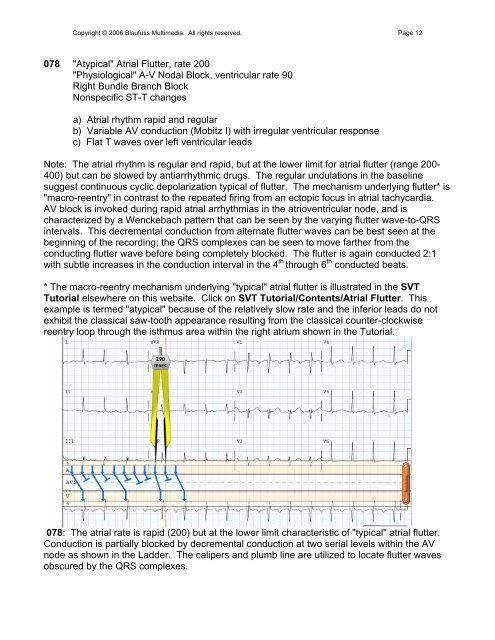002 Sinus Rhythm, atrial rate 90 Mobitz II - Blaufuss Multimedia
002 Sinus Rhythm, atrial rate 90 Mobitz II - Blaufuss Multimedia
002 Sinus Rhythm, atrial rate 90 Mobitz II - Blaufuss Multimedia
Create successful ePaper yourself
Turn your PDF publications into a flip-book with our unique Google optimized e-Paper software.
Copyright © 2006 <strong>Blaufuss</strong> <strong>Multimedia</strong>. All rights reserved. Page 12<br />
078 "Atypical" Atrial Flutter, <strong>rate</strong> 200<br />
"Physiological" A-V Nodal Block, ventricular <strong>rate</strong> <strong>90</strong><br />
Right Bundle Branch Block<br />
Nonspecific ST-T changes<br />
a) Atrial rhythm rapid and regular<br />
b) Variable AV conduction (<strong>Mobitz</strong> I) with irregular ventricular response<br />
c) Flat T waves over left ventricular leads<br />
Note: The <strong>atrial</strong> rhythm is regular and rapid, but at the lower limit for <strong>atrial</strong> flutter (range 200-<br />
400) but can be slowed by antiarrhythmic drugs. The regular undulations in the baseline<br />
suggest continuous cyclic depolarization typical of flutter. The mechanism underlying flutter* is<br />
"macro-reentry" in contrast to the repeated firing from an ectopic focus in <strong>atrial</strong> tachycardia.<br />
AV block is invoked during rapid <strong>atrial</strong> arrhythmias in the atrioventricular node, and is<br />
characterized by a Wenckebach pattern that can be seen by the varying flutter wave-to-QRS<br />
intervals. This decremental conduction from alternate flutter waves can be best seen at the<br />
beginning of the recording; the QRS complexes can be seen to move farther from the<br />
conducting flutter wave before being completely blocked. The flutter is again conducted 2:1<br />
with subtle increases in the conduction interval in the 4 th through 6 th conducted beats.<br />
* The macro-reentry mechanism underlying "typical" <strong>atrial</strong> flutter is illust<strong>rate</strong>d in the SVT<br />
Tutorial elsewhere on this website. Click on SVT Tutorial/Contents/Atrial Flutter. This<br />
example is termed "atypical" because of the relatively slow <strong>rate</strong> and the inferior leads do not<br />
exhibit the classical saw-tooth appearance resulting from the classical counter-clockwise<br />
reentry loop through the isthmus area within the right atrium shown in the Tutorial.<br />
078: The <strong>atrial</strong> <strong>rate</strong> is rapid (200) but at the lower limit characteristic of "typical" <strong>atrial</strong> flutter.<br />
Conduction is partially blocked by decremental conduction at two serial levels within the AV<br />
node as shown in the Ladder. The calipers and plumb line are utilized to locate flutter waves<br />
obscured by the QRS complexes.


